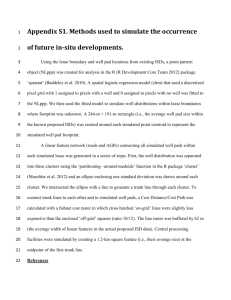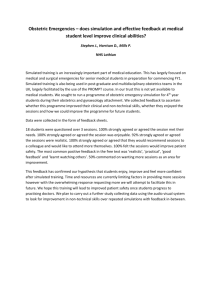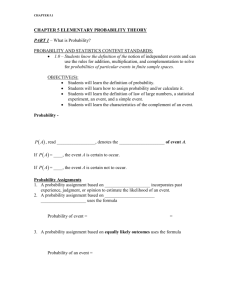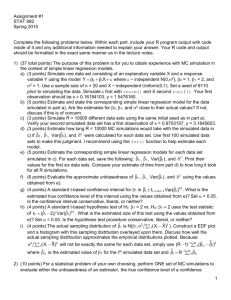Supplementary Material (doc 145K)
advertisement
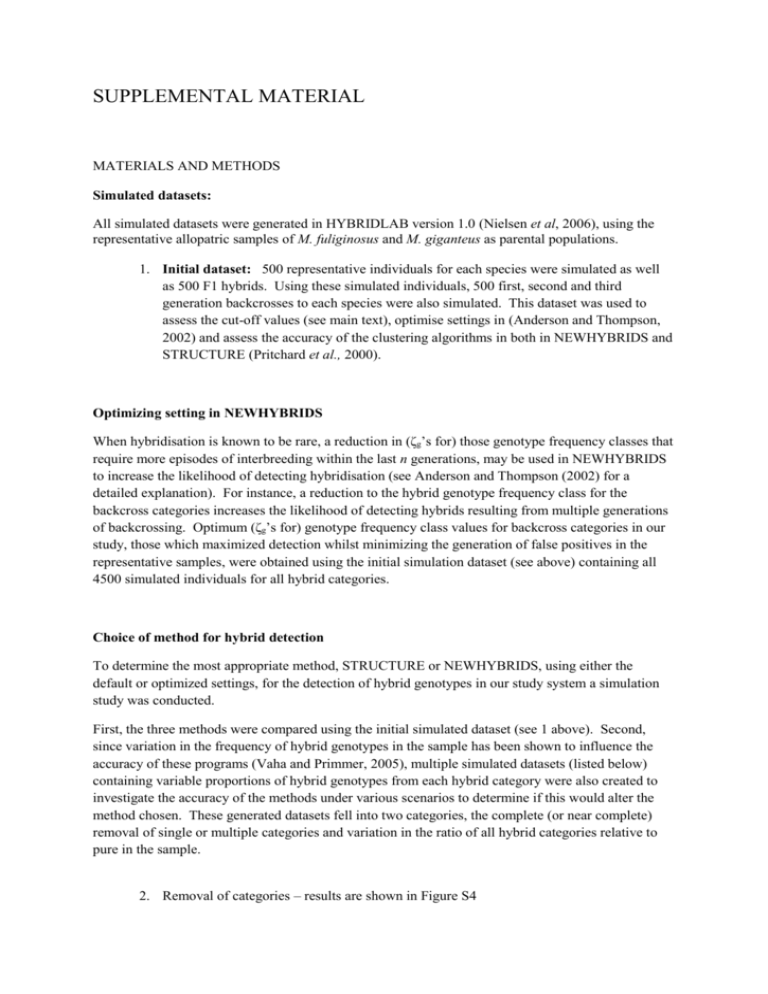
SUPPLEMENTAL MATERIAL MATERIALS AND METHODS Simulated datasets: All simulated datasets were generated in HYBRIDLAB version 1.0 (Nielsen et al, 2006), using the representative allopatric samples of M. fuliginosus and M. giganteus as parental populations. 1. Initial dataset: 500 representative individuals for each species were simulated as well as 500 F1 hybrids. Using these simulated individuals, 500 first, second and third generation backcrosses to each species were also simulated. This dataset was used to assess the cut-off values (see main text), optimise settings in (Anderson and Thompson, 2002) and assess the accuracy of the clustering algorithms in both in NEWHYBRIDS and STRUCTURE (Pritchard et al., 2000). Optimizing setting in NEWHYBRIDS When hybridisation is known to be rare, a reduction in (ζg’s for) those genotype frequency classes that require more episodes of interbreeding within the last n generations, may be used in NEWHYBRIDS to increase the likelihood of detecting hybridisation (see Anderson and Thompson (2002) for a detailed explanation). For instance, a reduction to the hybrid genotype frequency class for the backcross categories increases the likelihood of detecting hybrids resulting from multiple generations of backcrossing. Optimum (ζg’s for) genotype frequency class values for backcross categories in our study, those which maximized detection whilst minimizing the generation of false positives in the representative samples, were obtained using the initial simulation dataset (see above) containing all 4500 simulated individuals for all hybrid categories. Choice of method for hybrid detection To determine the most appropriate method, STRUCTURE or NEWHYBRIDS, using either the default or optimized settings, for the detection of hybrid genotypes in our study system a simulation study was conducted. First, the three methods were compared using the initial simulated dataset (see 1 above). Second, since variation in the frequency of hybrid genotypes in the sample has been shown to influence the accuracy of these programs (Vaha and Primmer, 2005), multiple simulated datasets (listed below) containing variable proportions of hybrid genotypes from each hybrid category were also created to investigate the accuracy of the methods under various scenarios to determine if this would alter the method chosen. These generated datasets fell into two categories, the complete (or near complete) removal of single or multiple categories and variation in the ratio of all hybrid categories relative to pure in the sample. 2. Removal of categories – results are shown in Figure S4 i. ii. iii. iv. v. None- Initial dataset (see 1 above) containing all simulated individuals 90% F1- 90% of simulated F1 hybrids removed from i. 95% F1- 95% of simulated F1 hybrids removed from i. F1- 100% simulated F1 hybrids were removed from i. F1&1Bx – 100% simulated F1 and 1st generation backcrosses removed from i. vi. F1, 1Bx&2Bx – 100% simulated F1, 1st and 2nd generation backcrosses removed from i. 3. Frequency of hybrids – results are shown in Figure S5 i. 0.25% - 3 F1 hybrids, 5 first generation backcrosses, 10 second generation 20, 3rd generation backcrosses and 1000 ‘pure’ ii. 0.5% - 5 F1 hybrids, 10 first generation backcrosses, 20 second generation 40, 3rd generation backcrosses and 1000 ‘pure’ iii. 1% - 10 F1 hybrids, 20 first generation backcrosses, 40 second generation, 80, 3rd generation backcrosses and 1000 ‘pure’ iv. 2.5% - 25 F1 hybrids, 50 first generation backcrosses, 100 second generation 200, 3rd generation backcrosses and 1000 ‘pure’ RESULTS Distinguishing Hybrid and Pure genotypes: Analysis of the initial simulated dataset in NEWHYBRIDS revealed that a definitive assignment was made (either correctly or incorrectly) in 81.8% of backcrosses in NEWHYBRIDS, see Figure S1. b. 1st generation backcrosses 2nd generation backcrosses 1 1 0.9 0.9 0.8 0.8 0.7 0.7 % of sample % of sample a. 0.6 0.5 0.4 0.6 0.5 0.4 0.3 0.3 0.2 0.2 0.1 0.1 0 0 1 0.95 0.90 0.85 0.80 0.75 0.65 Assignment probability 0.60 0.55 0.50 0.45 1 0.95 0.90 0.85 0.80 0.75 0.65 Assignment probability 0.60 0.55 3rd generation backcrosses 1 Figure S1: The assignment probabilities of simulated first (a), second (b) and third (c) generation backcrosses in NEWHYBRIDS. The black line indicates the cut-off value for a definitive assignment (0.75). 0.9 0.8 % of sample 0.7 0.6 0.5 0.4 0.3 0.2 0.1 0 1 0.95 0.90 0.85 0.80 0.75 0.65 Assignment probabiltiy 0.60 0.55 0.50 0.45 0.50 0.45 Optimizing Setting in NEWHYBRIDS The reduction in backcross hybrid genotype frequency classes in NEWHYBRIDS results in an increase in the proportion of simulated backcrosses which were distinguished (Figure S2). However, the likelihood of false positives in the representative sample also increased (Figure S2). Furthermore, the proportion of simulated first generation backcrosses correctly distinguished decreased with the decreasing backcross hybrid genotype frequency class (Figure S2), which was attributable to misidentification as F1s. The backcross genotype frequency class was reduced from 0.50 to 0.35 before false positives were evident in the representative individuals (0.02%), corresponding to an increase of 30.7% and 33.0% in the proportion of simulated second and third generation backcrosses distinguished respectively (Figure S2 and S3). It was not until this value was lowered to 0.15, that any representative individuals (3/1000) were misidentified with a high degree of certainty (>0.75). Therefore, in analyses of the empirical data, a value of 0.35 for backcross hybrid genotype frequency class was used, as this provided the highest proportion of correct assignment, overall. Comparisons between the results of optimised NEWHYBRIDS with the default settings did not yield additional information capable of consistently distinguishing between generations of backcrosses. However, individuals only detected using the optimised settings were more frequently second generation or later. 1 Proportion Correctly Assigned 1 Pure Total correct Pure 0.8Total correct F1backcross Total correct F1backcross Total Figure S2: The effect of reducing the hybrid Total genotype frequency class values for the backcross F2backcross correct 0.6 correct Pure Totalascorrect categories in NEWHYBRIDS on the identification of pure ( ) individuals well as first ( Total Total second ( )F2backcross and third ( ) F3backcross generation backcrosses. correct correct 0.8 0.6 0.4 F3backcross Total correct 0.4 0.6 0.7 0.8 0.9 0.2 brid genotype Frequency Class 0.2 0.8 0.9 0 F1backcross Total correct F2backcross Total correct F3backcross Total correct Pure Total corre ),F1backcross To correct F2backcross To correct F3backcross To correct Choice of Methodology for hybrid detection 1. Initial dataset: STRUCTURE distinguished 100% of F1 hybrids, 91.5% of simulated first generation backcrosses, 52.1% of simulated second generation backcrosses and 21.4% of third generation backcrosses from “pure” (Figure S3). However, due to overlapping Q values for simulated F1 hybrids (0.3-0.7) and backcrosses (0.43-0.98), a much lower proportion 64.0%, 50.1% and 21.2% of simulated first, second and third generation backcrosses respectively were correctly identified (Figure S3). Similar results were apparent in NEWHYBRIDS, with 100% of F1 hybrids, 90.4% of first generation backcrosses, 50.5% of second and 19.3% of third generation backcrosses distinguished from “pure” (Figure S3). Separation into hybrid categories did not substantially alter the proportion of individuals correctly assigned, with 98.6% of F1 hybrids, 85.5% of simulated first generation backcrosses, 50.5% of second and 19.3% of third generation backcrosses correctly identified (Figure S3). However, 4.7% of simulated first generation backcrosses were misidentified as F1 hybrids. Differences in the assignment probabilities of individuals could not be used to consistently separate generation of backcrossing. The proportion of backcrosses correctly identified increased using the optimised NEWHYBRIDS, with 92.9% first, 81.2% second and 52.3% of third generation backcrosses correctly identified (Figure S3). Proportion Correctly Assigned 1 0.8 0.6 0.4 0.2 0 Proportion Correctly Assigned 1 Pure F1 Bx1 Bx2 Bx3 Category 0.8 S first (Bx1), second (Bx2) Figure0.6 S3: Comparison of the proportion of first generation hybrids (F1), NH and third (Bx3) generation backcrosses by STRUCTURE S and pure individuals correctly assigned NH2 ( )Sand and optimised NEWHYBRIDS ( ). 0.4default NEWHYBRIDS ( )NH NH NH2 NH20.2 0 Pure F1 Bx1 Bx2 F1 Bx3 Bx1 Category Bx2 Bx3 2. Removal of Categories The removal of categories of hybrid categories decreased the proportion of the remaining simulated hybrids correctly identified using all methods (Figure S4), with this effect amplified by the removal of multiple groups (Figure S4). Optimised NEWHYBRIDS (Figure S4a) was least effected by the removal of simulated F1 hybrids, with an overall decrease in the detection of simulated backcrosses of less than 1%, compared with 3.9% in default NEWHYBRIDS (Figure S4b) and 15.3% in STRUCTURE (Figure S4c). Moreover, this decrease in detection was not substantially changed when a proportion (10 or 5%) of simulated F1 hybrids remained within the sample (Figure S4). The removal of multiple categories further reduced the proportion of backcross distinguished from pure (Figure S4). Overall, the optimised NEWHYBRIDS detected the highest proportion of simulated backcrosses. a b 1 0.8 0.8 Frequency correct Frequency correct 1 0.6 0.4 0.2 0.6 0.4 0.2 0 0 i ii iii iv v i vi ii iii Categories c iv Categories 1 b b 1 1 Frequency correct 0.8 Frequency correct 0.8 0.6 0.4 0.6 0 0.4 0.2 Pure 0 i 0.4 0.25% Pure F1 0.50% 1% 2.50% Frequency of Hybridization F2backcross Frequency of correct Hybridization 0.50% 1% Total 2.50% F3backcross Frequency of Hybridization Total correct F1 ,1 Bx &2 Bx F1 &1 Bx 1B x 0.6 iiPure F1 iii F1 iv v vi Categories F1backcross F1backcross F2backcross )F2backcross and third ( F3backcross ) generation 0.2 S2: The detection of first ( F1backcross Figure ), second ( backcrosses and pure F3backcross Total individuals ( )Pure by optimised NEWHYRBIDS (a), default NEWHYRBIDS (b) and STRUCTURE (c) F2backcross correct following the complete or partial removal of specific and combinations of hybrid categories (see text) 0 F3backcross F1backcross 0.25% 0.50% 1% 2.50% from the initial sample. Total correct 0.2 0.25% Frequency correct 0.8 rom sample v vi 3. Frequency of hybrids Variation in the ratio of hybrids in the sample (i.e. 2.5, 1, 0.5 and 0.25%) resulted in an overall reduction of 13% in optimised NEWHYBRIDS, 5.53% in default NEWHYBRIDS and 1% in STRUCTURE in distinguishing simulated backcrosses, following a reduction from 2.5% to 0.25% hybridisation (Figure S5). The largest reduction occurred between 0.5 and 0.25% regardless of the method. Some variation in accuracy at low frequencies (Figure S5) was associated with the individual genotypes included rather than an effect of relatively few hybrid genotypes in the sample. For instance only minor (<0.01) changes were apparent in the posterior probabilities of individuals used in multiple runs in either NEWHYBRIDS or STRUCTURE. Again, the optimised NEWHYBRIDS detected the greatest proportion of backcrosses. a b 1 0.8 Frequency correct Frequency correct 0.8 1 0.6 0.4 0.6 0.4 0.2 0.2 0 0 0.25% 0.50% 1% 0.25% 2.50% Frequency of hybridisation c 0.50% 1% Frequency of Hybridization 1 b b 0.8 1 0.8 0.6 0.4 Frequency correct 0.8 0.6 0.4 0.2 0.2 Frequency correct 1 0.8 1 0.6 0.4 Frequency correct b 1 Frequency correct 0.8 0.6 0.4 0.2 0.6 Pure 0 0.25% 0.50% Pure 1% F1 Frequency Pure of Hybridization 0.4 Pure F1 2.50%F1 F1backcross F1backcross F2backcross 0.2 Figure S5: The detection of F1 hybrids ( ),F1first ( ), second ( )F2backcross and third ( )F3backcross generation F1backcross Pure 0.2 F3backcross F1backcross backcrosses and pure individuals ( ) by optimised NEWHYRBIDS (a), default NEWHYRBIDS (b) F2backcross F1 and STRUCTURE (c)0 with varying frequencies of hybridization. F2backcross F3backcross 0 0.25% 0.25% 0.50% F1backcross 0.50% 1% F3backcross 1% 2.50% F2backcross Frequency of Hybridization 0 F3backcross Frequency of Hybridization 0 0.25% 0.50% 1% 2.50% 0.25% 0.50% 1% 2.50% Frequency of Hybridization Frequency of Hybridization 0.25% 0.50% 1% 2.50% Frequency of Hybridization 2.50% 2.50% Chosen Method The results of the simulation study revealed the highest proportion of correct assignments, in all scenarios, occurred using the optimised NEWHYBRIDS method, with ζg’s for the backcross categories genotype frequency classes set at 0.35. Hence this appeared the most appropriate method, to investigate hybridisation within our study system, since the frequency of hybridisation is expected to be low (Kirsch and Poole, 1972). However, the optimised settings resulted in the misidentification of 5.2% of the simulated first generation backcrosses as F1 hybrids. Therefore to detect the presence of F1 hybrids the empirical data was also examined with the default NEWHYBRIDS and STRUCTURE.



